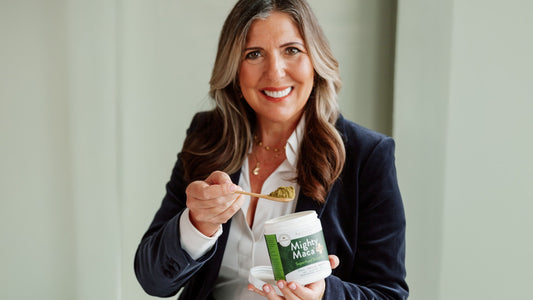If you’ve been feeling “wired and tired,” riding the ups and downs of stress, sleep, cravings, and mood swings—especially through perimenopause or menopause—you’re not alone. As a physician and women’s health advocate, I see this pattern every day. The good news? There are gentle, time-tested tools that help your body adapt. Enter adaptogens—and one of my favorites for stress resilience: maca.
In this guide, I’ll walk you through what adaptogens are, how maca supports your stress response, who it’s best for, how to choose and use it, and how to pair it with daily habits that restore calm energy. Think of this as your friendly 101, grounded in science and real-life experience from my clinic.

Adaptogens are a unique class of botanicals that help your body adapt to stressors—physical, emotional, or environmental—by nudging your stress response systems toward balance rather than pushing them in one direction. Classic adaptogens include maca, ashwagandha, rhodiola, holy basil, schisandra, and ginseng.
Adaptogens generally:
Are nonspecific (support a broad stress response, not a single symptom)
Have a normalizing effect (help regulate high or low activity toward center)
Are considered safe and well-tolerated at typical doses
How do they do this? At a high level, adaptogens communicate with your hypothalamic-pituitary-adrenal (HPA) axis—the network that governs cortisol, your primary stress hormone. When this axis is overworked (hello, modern life), you feel the fallout: anxiety, fatigue, sleep disruption, sugar cravings, weight changes, low motivation, and brain fog. Adaptogens help smooth the peaks and valleys so you can feel more even-keeled throughout the day.

Maca (Lepidium meyenii) is a cruciferous root vegetable native to the high Andes of Peru, traditionally consumed as food and tea for energy, stamina, fertility, and resilience at altitude. It comes in several phenotypes (yellow, red, and black) with slightly different traditional uses. It’s nutrient-dense and contains unique bioactive compounds—macamides and macaenes—along with polyphenols and glucosinolates.
What makes maca special for stress?
HPA axis support: Maca appears to influence the communication between your brain and adrenals, often experienced as steadier energy and mood.
Endocannabinoid tone: Early research suggests macamides may help modulate enzymes that influence endocannabinoids—molecules that affect calm, resilience, and pain perception.
Not a phytoestrogen in the usual sense: Unlike soy isoflavones, maca’s menopause benefits don’t seem to come from estrogen-like activity. Instead, it appears to work “upstream” at the hypothalamus and pituitary, which is helpful if you’re navigating hormone shifts but want to avoid direct estrogenic effects.
Maca and your stress response: what the research suggests
While we still need large, definitive trials, small human studies, and decades of traditional use point to several benefits highly relevant to stress tolerance:
Mood and well-being: Some trials in postmenopausal women reported reduced anxiety and depressive symptoms and improved sexual well-being with daily gelatinized maca compared to placebo.
Energy and fatigue: Historically used for stamina, many people report fewer afternoon crashes and steadier energy through the day.
Menopausal symptoms: Studies show improvements in subjective menopausal complaints (hot flashes, mood changes), likely via central (HPA) mechanisms rather than estrogenic effects.
Blood pressure and cortisol patterns: Preliminary research suggests a trend toward healthier stress reactivity, which many women feel as “I handle the day better.”
My clinical take: I don’t position maca as a magic bullet. It’s a daily teammate that helps the rest of your plan work better—sleep, nutrition, movement, mindset, and (if used) hormone therapy.

For many women, yes. Here’s why:
Cortisol steadies first: When cortisol is chaotic, everything feels harder. Maca often smooths the edges—less “freak out,” more “I’ve got this.”
Sleep and mood lift: Many women notice improved sleep continuity and daytime calm, which cascades into better food choices and consistent movement.
Work with you, not against you: Because maca doesn’t act like estrogen in the body, it can be a fit for women who can’t or prefer not to use estrogen, while still supporting resilience.
Important note: If you’re actively being treated for hormone-sensitive conditions, always discuss new supplements with your oncology or endocrine team. While maca isn’t estrogenic in the typical way, a personalized decision is essential.
Raw vs. gelatinized maca, colors, and quality
Not all maca is the same. A few pointers to choose wisely:
Gelatinized (pre-cooked) vs. raw: Gelatinized maca has been heated to remove most starch, making it easier to digest and concentrate active compounds. It’s my preferred form for most people, especially with sensitive digestion.
Colors: Yellow is the most common generalist. Red maca has been studied for prostate support; black maca is associated in preliminary work with energy and cognition. Blends are often used to cover bases.
Organic and altitude-sourced: Maca grown at traditional high altitudes appears to develop its characteristic phytochemicals more robustly. Choose organic to minimize contaminants.
Third-party testing: Look for brands that test for heavy metals, microbes, and identity/potency.
Typical dose ranges in studies are 1.5–3 grams daily, sometimes up to ~5 grams. Start low, stay consistent for a few weeks, then adjust based on how you feel.

I love a “stack” that matches your specific pattern of stress:
Maca: Calming energy and mood steadiness; great daytime ally. Often supportive in perimenopause/menopause for resilience and vitality.
Ashwagandha: Calming and sleep-supportive, with evidence for anxiety relief and cortisol modulation. Especially nice in the evening.
Rhodiola: Uplifting without “jangly” stimulation; supports mental endurance and anti-fatigue. Great earlier in the day.
Holy basil (Tulsi): Gentle, soothing, supports emotional balance and glycemic control.
Schisandra: Stress and liver support, helpful for daytime focus.
Panax ginseng: More stimulating; better for those with low energy and no anxiety.
You don’t need everything at once. Most of my patients do well starting with one to two adaptogens and building from there if needed. Maca pairs beautifully with ashwagandha (PM) and rhodiola (AM) for many women.
Consistency matters more than perfection. Give it 2–4 weeks of daily use to fairly assess how you feel.
Maca safety and who should be cautious
Maca is considered safe as a food in traditional cultures and generally well-tolerated as a supplement. That said, a few considerations:
Thyroid: Maca is a crucifer with glucosinolates. Cooking/gelatinization reduces goitrogenic potential, and most people tolerate it well. If you have hypothyroidism, ensure adequate iodine/selenium intake and monitor how you feel. Take thyroid medication away from supplements.
Pregnancy/breastfeeding: Safety data are limited. Check with your OB or midwife before use.
Hormone-sensitive conditions: While maca doesn’t act like estrogen in the body, always coordinate with your oncology/endocrinology team for personalized guidance.
Medications: Maca doesn’t have widely reported drug interactions, but if you’re on blood pressure meds, anticoagulants, or psychiatric medications, review with your clinician.
Listen to your body: If you feel jittery, wired, or off, lower the dose, change timing, or pause and reassess.
Remember: supplements are one part of a comprehensive plan. Your daily behaviors—sleep, nourishment, movement, relationships, and joy—do the heavy lifting.
A stress-smart daily framework (with maca inside)
MORNING
Sunlight in your eyes (not through glass) within an hour of waking to anchor your circadian rhythm.
Protein-forward breakfast (20–30 grams) to stabilize blood sugar and cortisol.
Maca dose in a smoothie or latte for focused energy.
5 minutes of breathwork: 4-7-8 or box breathing.
MIDDAY
10–20 minutes of walking after meals for glucose balance.
Strength training 2–3 days/week (compound movements, progressive overload).
Choose caffeine wisely; try a cutoff by noon if sleep suffers.
EVENING
Tech wind-down (blue light filters and screen break 60–90 minutes before bed).
Magnesium glycinate and/or ashwagandha for relaxation.
Gratitude practice or journaling to recalibrate your nervous system.
WEEKEND
Nature time (forest, beach, parks).
Community connection: laughter and love raise oxytocin, which naturally buffers cortisol.
Plan the week: meals, movement, sleep targets. Peace is a prepared nervous system.
My clinical pearls for making maca work for you
- Start simple: 1/2 teaspoon (or 500–750 mg capsule), morning, daily for 1–2 weeks. Notice shifts in energy, mood, cravings, and sleep.
Stack smart: If anxiety dominates, pair maca (AM) with ashwagandha (PM). If fatigue/focus is the main issue, add rhodiola (AM).
Support your gut: If you’re bloated, constipated, or have inconsistent stools, address digestion first. You can’t be resilient if you aren’t absorbing nutrients.
Data helps: Track sleep, energy, mood, and cravings for two weeks before and after starting maca. Let your results guide dose and timing.
A quick note on blends Over the years, I created a greens-and-adaptogen blend for my community that features maca alongside ashwagandha, turmeric, and other botanicals. I designed it to be a one-scoop daily ritual for calm energy and fewer sugar crashes. Use any high-quality option you trust; just be consistent and listen to your body.

If you’re experiencing:
Persistent exhaustion unrelieved by rest
Significant sleep disruption
Hot flashes/night sweats disrupting life
Anxiety or low mood affecting function
Sudden weight changes or blood pressure swings
…then consider layering additional support. This might include hormone therapy, thyroid and iron testing, nutrient repletion (vitamin D, magnesium, omega-3s), blood sugar support, and therapeutic counseling. Adaptogens are teammates, not replacements, for needed medical care.
You are designed to adapt
Your nervous system is plastic. Your hormones respond to your daily rhythms. Your bones, muscles, and brain remodel with the signals you send. I love maca because it reminds us of this truth: with the right inputs, your body re-finds balance.
If you try maca, tell me how you feel after 2–4 weeks of consistent use. And if you’re already a fan, consider pairing it with a short evening wind-down routine and 2–3 days of strength training. The combination is powerful.
You’ve got this, girlfriend—and I’ve got you.

Q: How much maca should I take daily for stress?
A: Most studies use 1.5–3 grams per day. Start with 500–1000 mg (about 1/2–1 tsp of gelatinized powder) in the morning, daily for 2–4 weeks, then adjust.
Q: When is the best time to take maca?
A: Morning or early afternoon works best because maca can be gently energizing. Avoid late evening unless you personally find it calming.
Q: What’s the difference between raw and gelatinized maca?
A: Gelatinized maca is heated to remove most starch, making it easier to digest and often better tolerated, especially for sensitive stomachs.
Q: Can I take maca with coffee?
A: Yes, many people add maca to coffee or matcha. If you’re sensitive to caffeine, try your maca in a caffeine-free latte or smoothie.
Q: Is maca safe with thyroid issues?
A: Most people with well-managed hypothyroidism tolerate gelatinized maca. Ensure you have adequate iodine/selenium, separate thyroid meds from supplements, and monitor how you feel.
Q: How long until I notice benefits?
A: Some feel steadier within a few days; for most, evaluate after 2–4 weeks of daily use. Track sleep, mood, energy, and cravings to see your trend.
Q: Can I take maca with ashwagandha or rhodiola?
A: Yes. A common stack is maca in the morning, rhodiola earlier in the day for focus, and ashwagandha in the evening for calm and sleep.
Q: Are there people who should avoid maca?
A: If pregnant, breastfeeding, or in active treatment for hormone-sensitive conditions, consult your clinician. Review any new supplement alongside your medications.
Disclaimer: This article is educational and not a substitute for personalized medical advice. Always consult your healthcare provider before starting new supplements, especially if you have medical conditions or take prescription medications.





